Spatial Assessment of Groundwater Salinity and Its Impact on Vegetation Cover Conditions in the Agricultural Lands of Al-Ahsa Oasis, Saudi Arabia
Abstract
1. Introduction
2. Materials and Methods
2.1. The Study Area
2.2. Collection and Preparation of Data
2.2.1. Field Data Collection
Saline Water Classification
2.2.2. Spatial Data Acquisition
2.2.3. Spatial Data Analysis
2.3. Spatial and Tabular Correlation Analysis
2.4. Presentation of the Work Flow
3. Results
3.1. Spatial and Field Data Mapping
3.2. Tabulating the Spatial Correspondences
3.3. Representation of Data Spatial Autocorrelation
3.3.1. The Applied BiLISA Approach
3.3.2. EC Centralization Effect (the Conditional Plot Maps)
4. Discussion
4.1. Statement of VCI, EC, and Texture Distribution
4.2. The Nature of Spatial Autocorrelation between Variables
5. Conclusions
- The vegetation health, as indicated by the VCI, exhibited significant spatial variations across the oasis. Notably, the northern and eastern oasis sectors claimed higher VCI values, indicative of robust vegetation cover, while the southwestern region demonstrated a contrasting trend with elevated groundwater salinity levels.
- A complex relationship exists between groundwater salinity and vegetation health. While “good condition” VCI predominantly co-occurred with slightly saline groundwater and silty loam soils, moderate salinity levels (2–10 dS m−1) displayed multifaceted associations with various VCI classes.
- BiLISA analysis revealed statistically significant clusters of both high salinity–low VCI and low salinity–high VCI, suggesting the influence of localized factors beyond simple salinity-driven effects. Furthermore, specific outlier districts shown atypical EC-VCI relationships, hinting at potentially mitigating influences such as land management practices.
- The role of soil texture in modulating VCI responses to salinity emerged as a crucial factor. Silt loam soils demonstrated a closer association with “good condition” VCI, whereas silty clay loam primarily supported dry and normal vegetation conditions. Notably, “silt” soils exhibited an ambiguous relationship, warranting further investigation.
Funding
Data Availability Statement
Acknowledgments
Conflicts of Interest
References
- Ayers, R.S.; Westcot, D.W. Water Quality for Agriculture; Food and Agriculture Organization of the United Nations: Rome, Italy, 1989; Volume 29. [Google Scholar]
- Guilherme, A.; Tormena, C.A.; Rattan, L.; Leandro, Z.; Claudinei, K. Enhancing soil physical quality and cotton yields through diversification of agricultural practices in central Brazil. Land Degrad Develop. 2019, 30, 788–798. [Google Scholar]
- Shrivastava, P.; Kumar, R. Soil salinity: A serious environmental issue and plant growth promoting bacteria as one of the tools for its alleviation. Saudi J. Biol. Sci. 2015, 22, 123–131. [Google Scholar] [CrossRef] [PubMed]
- FAO. Food and Agriculture Organization’s Handbook for Saline Soil Management. 2018. Available online: https://www.fao.org/publications (accessed on 4 December 2018).
- Dong, H. Combating salinity stress effects on cotton with agronomic practices. Afric. J. Agric. Res. 2012, 7, 4708–4715. [Google Scholar] [CrossRef]
- Munns, R. Comparative physiology of salt and water stress. Plant Cell Environ. 2002, 25, 239–250. [Google Scholar] [CrossRef] [PubMed]
- Tang, W.; Luo, Z.; Wen, S.; Dong, H.; Xin, C.; Li, W. Comparison of inhibitory effects on leaf photosynthesis in cotton seedlings between drought and salinity stress. Cotton Sci. 2007, 19, 28–32. [Google Scholar]
- Edelstein, M.; Plaut, Z.; Ben-Hur, M. Water salinity and sodicity effects on soil structure and hydraulic properties. Adv. Hortic. Sci. 2010, 24, 154–160. [Google Scholar]
- Nxele, X.; Klein, E.; Ndimba, B.K. Drought and salinity stress alters ROS accumulation, water retention and osmolyte content in sorghum plants. S. Af. J. Bot. 2017, 108, 261–266. [Google Scholar] [CrossRef]
- Carillo, P.; Maria, G.A.; Giovanni, P.; Amodio, F.; Pasqualina, W. Salinity Stress and Salt Tolerance, Abiotic Stress in Plants—Mechanisms and Adaptations; Shanker, A., Ed.; InTech: London, UK, 2011; Available online: https://www.intechopen.com/books/abioticstress-in-plants-mechanisms-and-adaptations/salinity-stress-and-salt-tolerance (accessed on 10 March 2020).
- Al-Omran, A.M.; Aly, A.; Al-Wabel, M.; Sallam, A.; Al-Shayaa, M. Hydrochemical characterization of groundwater under agricultural land in arid environment: A case study of Al-Kharj, Saudi Arabia. Arab. J. Geosci. 2016, 9, 68–85. [Google Scholar] [CrossRef]
- Al-Omran, A.; Aly, A.; Al-Wabel, M.I.; Al-Shayaa, M.S.; Sallam, A.S.; Nadeem, M.E. Geostatistical methods in evaluating spatial variability of groundwater quality in Al-Kharj Region, Saudi Arabia. Appl. Water Sci. 2017, 7, 4013–4023. [Google Scholar] [CrossRef]
- Al-Omran, A.M.; Awad, M.; Alharbi, M.; Nadeem, M. Hydrogeochemical characterization and groundwater quality assessment in Al-Hasa, Saudi Arabia. Arab. J. Geosci. 2018, 11, 79. [Google Scholar] [CrossRef]
- El-Mahmoudi, A.; Hussein, M. Geochemical modeling of groundwater salinization in Al-Ahsa Oasis, Saudi Arabia. Environ. Process. 2017, 4, 509–532. [Google Scholar]
- Aly, A.A.; Hussain, F.M.; Abd El-Moez, S.R. Assessment of groundwater quality in Al-Ahsa Oasis, Saudi Arabia using multivariate statistical analysis and GIS techniques. Environ. Earth Sci. 2013, 70, 3967–3992. [Google Scholar]
- Al-Zarah, A.I. Hydrochemistry and environmental significance of groundwater in Al-Ahsa Oasis, Saudi Arabia. Environ. Earth Sci. 2008, 56, 1607–1618. [Google Scholar]
- Al-Ahmadi, M. The impact of climate change on the water resources of Saudi Arabia. J. King Saud Univ.-Sci. 2010, 22, 207–217. [Google Scholar]
- Al-Jaber, F.; Ghulam, A. Estimation of potential and open water evaporation in arid regions using ERA-Interim reanalysis data. Arab. J. Geosci. 2014, 7, 3263–3270. [Google Scholar]
- Amer, M.A.; Hassan, F.A. Irrigation with treated wastewater and impact on soil properties in Al-Ahsa Oasis, Saudi Arabia. Agric. Water Manag. 2008, 95, 801–806. [Google Scholar]
- Bakhit, M.K.; Al-Ahmadi, M.A.; Al-Ghamdi, A.S. Numerical modeling of seawater intrusion in the eastern coast of Al-Ahsa Oasis, Saudi Arabia. J. King Saud Univ.-Sci. 2017, 29, 309–321. [Google Scholar]
- Todd, D.K.; Mays, L.W. Groundwater Hydrology, 3rd ed.; John Wiley & Sons: Hoboken, NJ, USA, 2005. [Google Scholar]
- Fetter, C.W. Applied Hydrogeology, 4th ed.; Prentice Hall: Upper Saddle River, NJ, USA, 2001. [Google Scholar]
- Bear, J.; Verruijt, A. Modeling Groundwater Flow and Pollution; D. Reidel Publishing Company: Dordrecht, The Netherlands, 1987. [Google Scholar]
- Allbed, A.; Kumar, L. Soil salinity and vegetation cover change detection from multi-temporal remotely sensed imagery in Al Hassa Oasis in Saudi Arabia. Environ. Earth Sci. 2016, 70, 3967–3992. [Google Scholar] [CrossRef]
- Menenti, M.; Van Deursen, W.; De Haan, F.J. Satellite-based detection of changes in surface water quality. Int. J. Remote Sens. 1986, 7, 1437–1454. [Google Scholar]
- Madani, K. Land salinization mapping in arid regions using remote sensing techniques. J. Indian Soc. Remote Sens. 2005, 33, 309–316. [Google Scholar]
- Shrestha, M.B. Landsat-based estimates of soil salinity in the Terai Region of Nepal. Int. J. Remote Sens. 2006, 27, 3703–3715. [Google Scholar]
- Bannari, A.; Guedira, M.; Hajab, E.L.; Omasa, K.; Kawamura, H. Monitoring and spatial modeling of soil salinity in irrigated areas using a spectral index derived from landsat-5 TM imagery. Int. J. Remote Sens. 2008, 29, 6603–6624. [Google Scholar]
- Allbed, A.; Kumar, L.; Aldakheel, Y.Y. Mapping of soil salinity using landsat data and support vector machines in Al-Hassa Oasis, Saudi Arabia. Arab. J. Geosci. 2014, 7, 3269–3282. [Google Scholar]
- Fernández-Buces, A.; Camacho-Ordoñez, C.; Plaza, A.; García-Haro, F.J. Spectral indices for the automatic recognition of saline areas in imagery-based irrigation management. Agron. J. 2006, 98, 720–729. [Google Scholar]
- Lobell, D.B.; Asner, G.P.; Heilman, C.M.; Baez, S. Remote sensing of regional crop yield variability. Proc. Natl. Acad. Sci. USA 2010, 107, 20924–20929. [Google Scholar]
- Al-Mulla, M.M.; Al-Adawi, S.S. Temporal changes in soil salinity mapping using remote sensing and GIS techniques in the Al-Rumais region, Oman. Environ. Monit. Assess. 2009, 159, 309–320. [Google Scholar]
- Tripathi, N.K.; Rao, A.R.; Sharma, R.A. Mapping of soil salinity using remote sensing. Int. J. Remote Sens. 1997, 18, 2909–2915. [Google Scholar]
- Al-Khaier, F. Application of remote sensing techniques for the detection of soil salinity in arid and semi-arid regions. Adv. Space Res. 2003, 32, 1423–1430. [Google Scholar]
- Nield, A.A.; Running, S.W.; Gowda, S.H. Remote sensing of soil salinity in the Colorado River Basin. Remote Sens. Environ. 2007, 109, 354–364. [Google Scholar]
- Al-Naeem, A.A. Evaluation of groundwater of al-hassa oasis, eastern region Saudi Arabia. Res. J. Environ. Sci. 2011, 5, 624–642. [Google Scholar]
- Al-Sayari, S.; Zott, J.G. Quaternary Period in Saudi Arabia; Springer: Wien, NY, USA, 1978. [Google Scholar]
- Elprince, A.M.; Makki, Y.M.; Al-Barrak, S.A.; Tamim, T.M. Use of Computer Graphics in developing density maps for the date culture of Al-Hassa oasis in Saudi Arabia. In Proceedings of the First Symposium on Date Palm Conference, Al-Hassa, Saudi Arabia, 23–25 March 1982; pp. 674–682. [Google Scholar]
- Wakuti. Studies for the Project of Improving Irrigation and Drainage in the Region of al-Hassa, Saudi Arabia; Soil Study: Siegen, Germany, 1969; p. 3. [Google Scholar]
- Rhoades, J.D.; Kandiah, A.; Mashali, A.M. The Use of Saline Waters for Crop Production FAO irrigation and Drainage Paper; FAO: Rome, Italy, 1992; p. 48. [Google Scholar]
- Hengl, T.; Mendes de Jesus, J.; Heuvelink, G.B.M.; Ruiperez Gonzalez, M.; Kilibarda, M.; Blagotić, A.; Shangguan, W.; Wright, M.N.; Geng, X.; Bauer-Marschallinger, B.; et al. SoilGrids250m: Global gridded soil information based on machine learning. PLoS ONE 2017, 12, e0169748. [Google Scholar] [CrossRef]
- Congedo, L. Semi-automatic classification plugin documentation. Release 2016, 3, 29. [Google Scholar]
- Silleos, N.G.; Alexandridis, T.K.; Gitas, I.Z.; Perakis, K. Vegetation indices: Advances made in biomass estimation and vegeta-tion monitoring in the last 30 years. Geocarto. Int. 2006, 21, 21–28. [Google Scholar] [CrossRef]
- Johansen, B.; Tømmervik, H. The relationship between phytomass, NDVI and vegetation communities on Svalbard. Int. J. Appl. Earth Obs. Geoinf. 2014, 27, 20–30. [Google Scholar] [CrossRef]
- Du, L.; Tian, Q.; Yu, T.; Meng, Q.; Jancso, T.; Udvardy, P.; Huang, Y. A Comprehensive Drought Monitoring Method Integrating MODIS and TRMM Data. Int. J. Appl. Earth Obs. Geoinf. 2013, 23, 245–253. [Google Scholar] [CrossRef]
- Zhuo, Z.Y.; Long, Q.B.; Bai, P. Scale of Meteorological Drought Index Suitable for Characterizing Agricultural Drought: A Case Study of Hunan Province. J. South-to-North Water Transf. Water Sci. Technol. 2021, 19, 119–128. [Google Scholar]
- Kogan, F.N.; Gitelson, A.; Edige, Z.; Spivak, I.; Lebed, L. AVHRR-based spectral vegetation index for quantitative assessment of vegetation state and productivity: Calibration and validation. Photogramm. Eng. Remote Sens. 2003, 69, 899–906. [Google Scholar] [CrossRef]
- Myers, J.L.; Well, A.D. Research Design and Statistical Analysis, 2nd ed.; Erlbaum: Lawrence, KS, USA, 2003; p. 508. ISBN 978-0-8058-4037-7. [Google Scholar]
- Anselin, L. Exploring Spatial Data with GeoDa: A Workbook; Center for Spatially Integrated Social Science, University of Illinois: Urbana, IL, USA, 2015; p. 61801. [Google Scholar]
- Anselin, L. Spatial regression in a multivariate framework. Spat. Anal. Geogr. Inf. Syst. 1995, 1, 31–52. [Google Scholar]
- Anselin, L.; Syabri, I.; Kho, Y. GeoDa: An introduction to spatial data analysis. Geogr. Anal. 2006, 38, 5–22. [Google Scholar] [CrossRef]
- Jamil, A.; Ahmad, R.; Qadir, M. Relationship between soil salinity and vegetation indices in agricultural landscapes of Punjab, Pakistan. Remote Sens. Lett. 2023, 14, 749–755. [Google Scholar]
- Qiu, L.; Zhang, X.; Zhao, X.; Yang, Z.; Zhang, Z. Exploring the influence of soil salinity on maize vegetation indices and yield using sentinel-2 and sentinel-1 data. Remote Sens. 2022, 14, 1696. [Google Scholar] [CrossRef]
- Gao, J.; Xu, W.; Zhao, H.; Yang, D.; Wang, R. Spatiotemporal changes in soil salinity and their impacts on vegetation greenness in irrigated agricultural land using Sentinel-2 data. Remote Sens. Environ. 2023, 282, 111305. [Google Scholar]
- Chen, X.; Cui, X.; Zhao, Z.; Chen, B.; Li, R. Spatiotemporal analysis of land salinization and its impact on vegetation coverage in the Ebinur Lake Basin, China. Remote Sens. 2022, 14, 4005. [Google Scholar] [CrossRef]
- Elhag, A.M.; Al-Barakati, F. A hybrid approach for vegetation condition monitoring, groundwater salinity and land degradation detection in the coastal arid region of Saudi Arabia. Sustain. Ecosyst. Resour. 2021, 10, 1567–1584. [Google Scholar]
- Aldakheel, A.A. Soil salinity as a selection pressure is a key determinant for the presence of halophytes in Al-Ahsa Oasis, Eastern Saudi Arabia. Saudi J. Biol. Sci. 2010, 17, 191–196. [Google Scholar] [CrossRef]
- Al-Rashed, M.M.; Elhag, M.; Al-Barakati, F. Assessing land degradation and desertification risks in Al-Ahsa Oasis, Saudi Arabia, using GIS techniques. Appl. Ecol. Environ. Res. 2017, 15, 703–724. [Google Scholar]







| Class of Water | EC (dS/m) | Concentration of Salts (mg/L) | Water Category |
|---|---|---|---|
| No salinity | <0.7 | <500 | Drinking as well as irrigation |
| Slight salinity | 0.7–2 | 500–1500 | Irrigation |
| Moderate salinity | 2–10 | 1500–7000 | Main drainage water/groundwater |
| Highly saline | 10–25 | 7000–15,000 | Secondary drainage water/groundwater |
| Very High salinity | 25–45 | 15,000–35,000 | Very saline groundwater |
| Brine | >45 | >35,000 | Seawater |
| Type of Data | Date of Data Attainment | Data Specifications | Data Source | |
|---|---|---|---|---|
| Satellite imagery [Sentinel-2A] | 2019 | 19 July | Path/row: 164/42 Spectral bands: 12 channels Pixel size: 10 m (for RGB bands) Revisit frequency (days): 5 | The European Space Agency’s (ESA) Copernicus program |
| 2020 | 3 July | |||
| 2021 | 23 July | |||
| 2022 | 18 July | |||
| 2023 | 8 July | |||
| Soil texture | 2023 | Format: Geo. Tiff. Resolution: 250 m at 30 cm depth. Coordinate reference system: EPSG: 4326. | The International Soil Reference and Information Centre (ISRIC) | |
| Collected EC data (dS m−1) | ||||
| Max | 9.60 | This statistical representation is based on 50-wells sample size. | ||
| Min | 1.79 | |||
| Avg. | 4.47 | |||
| STD | 1.34 | |||
| CV | 0.30 | |||
| VCI Categories | Total | ||||||
|---|---|---|---|---|---|---|---|
| Extremely Dry (0–20%) | Dry (20–40%) | Normal Condition (40–60%) | Good Condition (60–80%) | ||||
| EC (dS m−1) Categories | Slightly saline (0.7–2) | Count | 0 | 0 | 2 | 5 | 7 |
| % within EC Categories | 0.0% | 0.0% | 28.6% | 71.4% | 100.0% | ||
| Moderately saline (2–10) | Count | 4 | 14 | 12 | 13 | 43 | |
| % within EC Categories | 9.3% | 32.6% | 27.9% | 30.2% | 100.0% | ||
| Total | Count | 4 | 14 | 14 | 18 | 50 | |
| % within EC Categories | 8.0% | 28.0% | 28.0% | 36.0% | 100.0% | ||
| Texture | Silty clay loam | Count | 0 | 2 | 2 | 0 | 4 |
| % within Texture | 0.0% | 50.0% | 50.0% | 0.0% | 100.0% | ||
| Silt | Count | 1 | 2 | 3 | 3 | 9 | |
| % within Texture | 11.1% | 22.2% | 33.3% | 33.3% | 100.0% | ||
| Silt loam | Count | 3 | 10 | 9 | 15 | 37 | |
| % within Texture | 8.1% | 27.0% | 24.3% | 40.5% | 100.0% | ||
| Total | Count | 4 | 14 | 14 | 18 | 50 | |
| % within Texture | 8.0% | 28.0% | 28.0% | 36.0% | 100.0% | ||
| Tests | Symmetric | Value | Approximate Significance | |
|---|---|---|---|---|
| Ordinal by Ordinal | Somers’ d Correlation | VCI Category Dependent | −0.532 | 0.009 |
| Nominal by Interval | Eta | VCI Category Dependent | 0.131 | |
| N of Valid Cases | 50 | |||
Disclaimer/Publisher’s Note: The statements, opinions and data contained in all publications are solely those of the individual author(s) and contributor(s) and not of MDPI and/or the editor(s). MDPI and/or the editor(s) disclaim responsibility for any injury to people or property resulting from any ideas, methods, instructions or products referred to in the content. |
© 2024 by the author. Licensee MDPI, Basel, Switzerland. This article is an open access article distributed under the terms and conditions of the Creative Commons Attribution (CC BY) license (https://creativecommons.org/licenses/by/4.0/).
Share and Cite
Hassaballa, A. Spatial Assessment of Groundwater Salinity and Its Impact on Vegetation Cover Conditions in the Agricultural Lands of Al-Ahsa Oasis, Saudi Arabia. Water 2024, 16, 643. https://doi.org/10.3390/w16050643
Hassaballa A. Spatial Assessment of Groundwater Salinity and Its Impact on Vegetation Cover Conditions in the Agricultural Lands of Al-Ahsa Oasis, Saudi Arabia. Water. 2024; 16(5):643. https://doi.org/10.3390/w16050643
Chicago/Turabian StyleHassaballa, Abdalhaleem. 2024. "Spatial Assessment of Groundwater Salinity and Its Impact on Vegetation Cover Conditions in the Agricultural Lands of Al-Ahsa Oasis, Saudi Arabia" Water 16, no. 5: 643. https://doi.org/10.3390/w16050643
APA StyleHassaballa, A. (2024). Spatial Assessment of Groundwater Salinity and Its Impact on Vegetation Cover Conditions in the Agricultural Lands of Al-Ahsa Oasis, Saudi Arabia. Water, 16(5), 643. https://doi.org/10.3390/w16050643





